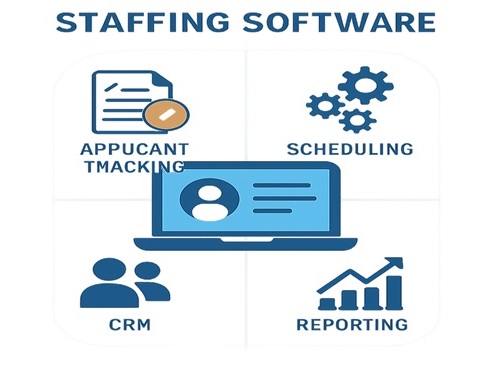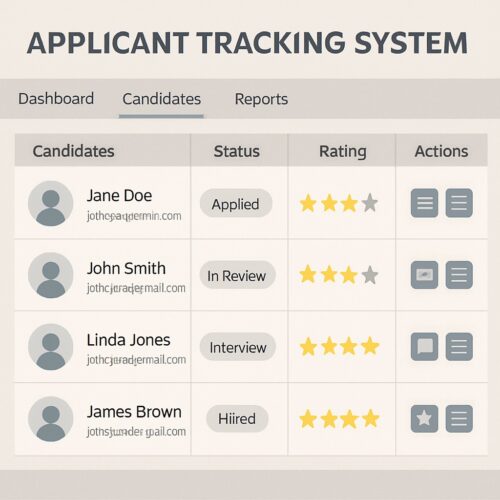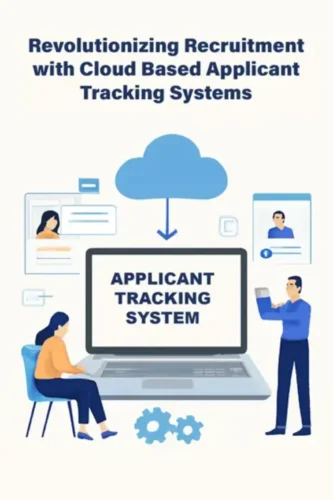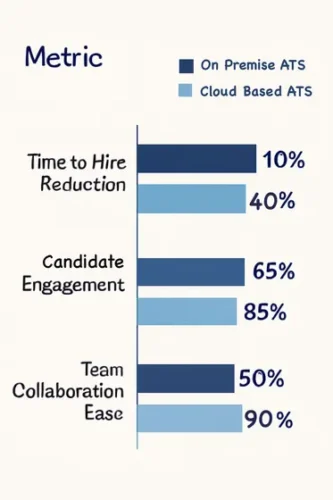Month: August 2025
The Ultimate Guide on Staffing Agency Software
Staffing agency software is transforming the recruitment landscape. It streamlines processes, saving time and reducing errors. This guide will explore the benefits and features of staffing software. You’ll learn how it can enhance your agency’s efficiency. Choosing the right software is crucial for success. We’ll provide insights into selection criteria and key trends. Whether you’re a staffing agency owner or HR professional, this guide is for you. It will help you make informed decisions. Discover how staffing solutions can improve your recruitment processes. Embrace technology to stay ahead in the competitive staffing industry.
What is staffing agency software?
Staffing agency software is a digital tool designed to simplify recruitment tasks. It helps manage candidate applications and client relationships efficiently. These tools are equipped with features for every step of the recruitment process. They offer solutions from job posting to onboarding.
Key features of staffing software typically include:
- Applicant tracking systems
- Resume parsing
- Client management tools
Enhancing communication is another core benefit. Automated messaging keeps candidates and clients informed. The software integrates with job boards and HR platforms, enhancing reach. This ensures seamless operations within the agency. It reduces manual errors and saves time.
Key features of staffing software
Staffing software is packed with essential features to aid recruitment. These tools automate tedious tasks to enhance efficiency and accuracy. They ensure that staffing agencies operate smoothly. Firstly, applicant tracking stands out. It allows agencies to manage candidates through the recruitment pipeline. This eliminates the need for constant manual updates. Resume parsing is another key feature. This tool swiftly extracts information from resumes. It saves recruiters time and ensures data consistency. Many staffing solutions include client relationship management tools. These help maintain strong client connections, fostering repeat business. A good CRM feature is vital for growth. Automation is also crucial. Automated communication tools keep candidates engaged. This enhances the recruitment experience.
Other essential features include:
- Data analytics for recruitment insights
- Integration capabilities for seamless operation
- Mobile accessibility for on-the-go recruiters

Data security features, such as encryption and authentication, protect sensitive details. These safeguards are non-negotiable in today’s digital world. Lastly, scalability in software ensures it can grow alongside your agency’s needs. As the agency expands, the software remains effective and supportive.
Benefits of using software for staffing agencies
Adopting staffing agency software presents numerous benefits. Streamlined processes lead the list. This software reduces manual errors, enhancing workflow efficiency. Time savings become evident quickly. By automating tasks, recruiters can focus on high-value activities. This results in quicker placements and increased productivity. Collaboration improves significantly with shared access to candidate data. Teams work better together, enhancing decision-making and strategy formulation. This collective effort boosts recruitment success. Robust data analytics in staffing solutions offer valuable insights. Agencies can track performance metrics and spot trends, guiding strategic planning. This data-driven approach enhances business outcomes.
Additional advantages include:
- Compliance management with labor laws
- Enhanced candidate engagement through automated communication
- Improved client relations through CRM tools
These benefits ultimately lead to better hires, greater client satisfaction, and a competitive edge in the recruitment landscape. Utilizing staffing agency software transforms recruitment practices for the better.
Types of staffing company software
Various types of staffing company software cater to different needs. Each software type serves a specific function, allowing agencies to choose what’s best for them. Applicant Tracking Systems (ATS) are common choices. They help manage candidate applications efficiently. These systems streamline the entire hiring process, from start to finish. Recruitment CRM software focuses on client relationships. It enhances interactions with clients and candidates. Maintaining strong relationships contributes to agency success. All-in-one staffing platforms are also popular. They integrate multiple functions into a single system, offering comprehensive solutions. This integration simplifies operations, making it easier for agencies to manage.
Key types of staffing software include:
- Applicant Tracking Systems (ATS)
- Recruitment CRM software
- All-in-one staffing platforms
Choosing the right type depends on agency needs and priorities. Understanding these options helps in making informed decisions.
How to choose the right staffing solutions
Selecting the right staffing solutions involves careful consideration. Agencies need to evaluate their unique requirements. Start by identifying core functions your agency demands. Consider the software’s features and scalability. It should accommodate your current needs and future growth. Scalability ensures the software remains effective long-term. Integration capabilities with existing tools are crucial. Seamless integration improves workflow efficiency. Confirm the software can connect with your current systems. User experience is also key. A user-friendly interface ensures quick adoption by your team. Easy-to-use software reduces training time and costs.
Here are factors to consider:
- Core functions and needs
- Feature set and scalability
- Integration capabilities
- User experience
Additionally, consider budget constraints. Evaluate subscription fees and potential ROI. This helps ensure the software is a viable long-term investment.
Top trends in recruiting agency software
The recruitment landscape is constantly evolving. One top trend is the use of AI-driven candidate matching. This feature enhances precision in selecting potential candidates. Cloud-based solutions are also gaining popularity. They allow for remote and flexible access. Agencies can operate seamlessly from anywhere in the world. Mobile compatibility is another crucial trend. Recruiters need mobile access to perform tasks on the go. This increases efficiency and responsiveness.
Here are current trends to watch:
- AI-driven candidate matching
- Cloud-based solutions
- Mobile compatibility
Embracing these trends can give your agency a competitive edge. Staying updated with the latest developments is key to success. Innovate to improve your recruitment process continuously.
Implementation tips and best practices
Successful implementation of staffing agency software requires planning. Begin by aligning the software with your agency’s processes. This ensures smooth integration and minimal disruption. Engage your team early in the process. Their input is valuable for identifying needs and challenges. Training sessions should follow to help staff adapt quickly. Continuously evaluate the software’s impact on your operations. Make adjustments to optimize performance. Regular reviews ensure the software evolves with your agency.
Consider these practices for implementation:
- Align software with agency processes
- Engage and train your team
- Evaluate and adjust regularly
Implementing these tips will drive efficiency and success. Investing time in the setup phase is crucial. This preparation fosters long-term benefits.
Frequently asked questions about staffing agency software
Staffing agency software can be complex. Many agencies have questions. Here are common queries with brief answers.
What features are essential for staffing software?
Key features include applicant tracking, resume parsing, and client management tools. These functions streamline processes.
Is it costly to implement?
Costs vary, but potential ROI often justifies the investment. Consider trial periods or demos to assess value.
Can the software integrate with our existing tools?
Most modern solutions offer integration capabilities. Check compatibility with your current tools before committing.
Common inquiries include:
- Essential software features
- Implementation costs
- Integration capabilities
These FAQs address initial concerns. Understanding these basics helps in selecting the right software. Explore deeper for a tailored solution.
Conclusion
Choosing the right staffing agency software can transform your recruitment processes. It streamlines operations and enhances efficiency. Key features offer significant competitive advantages. Evaluate your specific needs and explore options wisely. A well-suited solution can save time and improve the quality of hires. The benefits are clear for those who invest thoughtfully in the right technology.
Understanding ATS Systems: A Comprehensive Guide
In today’s competitive job market, finding the right candidate for a position can be a daunting task. This is where ATS systems, or Applicant Tracking Systems, come into play. These powerful tools help streamline the recruitment process, making it easier for HR professionals to manage applications and track candidates throughout the hiring process. In this comprehensive guide, we will explore everything you need to know about ATS systems, including their types, benefits, and how to choose the best one for your needs.
An Applicant Tracking System (ATS) is a software application that helps organizations manage their recruitment and hiring processes. It automates the process of tracking, evaluating, and managing job applications, making it easier for HR teams to find the best candidates for their open positions. With the rise of digital recruitment, ATS systems have become an essential tool for companies looking to streamline their hiring process and improve their recruitment analytics.

Benefits of Using an ATS
Using an ATS system can provide numerous benefits for your organization. Let’s take a closer look at some of the key advantages:
Improved Efficiency
ATS systems automate many time-consuming tasks in the recruitment process, such as sorting through resumes and tracking candidate progress. This frees up valuable time for HR professionals, allowing them to focus on more strategic tasks like interviewing and decision-making.
Enhanced Candidate Experience
A well-implemented ATS system can improve the candidate experience by providing a seamless and transparent application process. Candidates can easily track their application status and receive timely updates, which helps keep them engaged and reduces the likelihood of them dropping out of the process.
Better Data Management
ATS systems centralize all candidate information in one place, making it easier for recruiters to access and analyze data. This not only helps in making more informed hiring decisions but also provides valuable insights into recruitment trends and performance.
Increased Collaboration
Many ATS systems offer collaboration features that allow HR teams to work together more effectively. Recruiters can share candidate profiles, leave feedback, and communicate easily within the platform, ensuring everyone is on the same page throughout the hiring process.

Types of Applicant Tracking Systems
There are several types of ATS systems available, each designed to cater to different organizational needs. Here are some of the most popular types:
Standalone ATS
A standalone ATS is a dedicated software solution specifically designed for applicant tracking. It focuses solely on managing the recruitment process and typically offers a wide range of features tailored to the needs of hiring teams. These systems are ideal for organizations that require advanced recruitment capabilities and prefer a specialized solution.
Integrated ATS
An integrated ATS is part of a larger HR software suite, such as a Human Resource Management System (HRMS) or Human Capital Management (HCM) platform. These systems offer a comprehensive approach to managing various HR functions, including recruitment, payroll, and employee management. Integrated ATS solutions are suitable for organizations looking for an all-in-one HR solution.
Cloud-Based ATS
Cloud-based ATS systems are hosted on remote servers and accessed via the internet. They offer several advantages, such as easy implementation, scalability, and remote access. Cloud-based solutions are ideal for organizations that require flexibility and want to minimize their IT infrastructure costs.
On-Premise ATS
On-premise ATS systems are installed and maintained on a company’s local servers. These solutions provide greater control over data security and customization but may require significant IT resources for implementation and maintenance. On-premise ATS systems are suitable for organizations with specific security or compliance requirements.
Top-Rated Applicant Tracking Systems
With so many ATS systems available, it can be challenging to choose the best one for your organization. Here are some top-rated applicant tracking systems that have gained popularity among HR professionals:
1. recruitChamp
recruitChamp is a highly efficient, customizable ATS designed to meet the diverse needs of growing organizations. It stands out for its AI-powered candidate screening, mobile-friendly interface, and customizable workflows, which help streamline the recruitment process. recruitChamp also includes advanced reporting capabilities to track hiring performance, CRM tools for building candidate relationships, and seamless integration with other HR tools, making it an all-in-one solution for modern recruitment needs. Additionally, its diversity and inclusion features ensure that companies can track and enhance their D&I efforts throughout the hiring process.
2. Greenhouse
Greenhouse is a powerful ATS that focuses on providing a structured and data-driven approach to recruitment. It offers a wide range of features, including interview scheduling, candidate scorecards, and robust analytics. Greenhouse is known for its intuitive interface and strong integration capabilities.
3. Lever
Lever is a user-friendly ATS that emphasizes collaboration and communication among hiring teams. It offers features such as customizable pipelines, automated workflows, and advanced reporting. Lever’s seamless integration with popular tools like Slack and LinkedIn makes it a popular choice for growing companies.
4. BambooHR
BambooHR is a comprehensive HR software suite that includes an integrated ATS. It offers features such as job posting, applicant tracking, and onboarding. BambooHR’s user-friendly interface and strong customer support make it a popular choice among small to mid-sized businesses.
How to Choose the Best ATS System for Your Needs
Selecting the right ATS system for your organization can significantly impact your recruitment success. Here are some factors to consider when evaluating different ATS options:
Features
Identify the key features your organization needs in an ATS, such as resume parsing, candidate tracking, and integration capabilities. Make sure the system you choose offers the functionality required to support your recruitment process.
Scalability
Choose an ATS system that can grow with your organization. Look for solutions that offer flexible pricing plans and the ability to add or remove features as your needs change.
Usability
An intuitive and user-friendly interface is essential for ensuring your team can effectively use the ATS system. Look for solutions that offer a clean design and easy navigation to minimize the learning curve.
Integration
Ensure the ATS system you choose can seamlessly integrate with your existing HR tools and platforms. This will help streamline your recruitment process and reduce the need for manual data entry.
Support
Choose a provider that offers reliable customer support and resources to help you get the most out of your ATS system. This can include training, documentation, and troubleshooting assistance.
Conclusion
ATS systems play a crucial role in modern recruitment processes, helping organizations efficiently manage applications and track candidates. By understanding the different types of ATS systems and considering your organization’s specific needs, you can select the best solution to enhance your recruitment efforts and improve overall hiring success. Whether you’re a small business or a large enterprise, investing in a top-rated applicant tracking system can make a significant difference in your ability to attract and retain top talent.
How Cloud-Based Applicant Tracking Systems Are Transforming Recruitment
As hiring becomes increasingly competitive, recruiters need technology that is not only efficient but flexible. A cloud-based applicant tracking system (ATS) or online applicant tracking system provides significant advantages over conventional software and helps to improve collaboration, scalability, and user experience while streamlining the hiring process. This blog discusses the key benefits of cloud ATS, how it works, and why it is becoming necessary for today’s HR teams.
More than ever, recruitment is complicated for hiring teams sorting through many applications, working remotely, and trying to provide candidates with a great experience. On-site applicant tracking systems, while beneficial in the past, do not offer much flexibility and scalability. Enter cloud-based applicant tracking systems, a versatile, cloud-based solution that is available whenever you are ready to log in from anywhere, and offers the opportunity to build significant efficiencies into a recruitment workflow. This blog intends to offer you insights into the nature of this technology, how it is changing the way businesses hire, and why your business should consider switching.
How Does a Cloud-Based Applicant Tracking System Work?
A cloud-based applicant tracking system stores all recruitment data on the provider’s remote servers to be accessed online. This lets every hiring team work from any location, time zone, or device, and keeps them synchronized with real-time data. The cloud storage provider is responsible for the system, so if anything needs to be updated, it is automatically updated, meaning no complex local IT infrastructure to manage. Some of the main features of a cloud-based ATS may include applicant tracking, interview scheduling, communication tools, and integration with other HR and financial software.

Benefits of a Cloud-Based Applicant Tracking System
Access & Flexibility: Access your recruitment data at any time, any time and from any connected device. This is especially useful when working with distributed teams and or in situations where you are doing a lot of your hiring remotely.
Increased Collaboration: All team members can evaluate applicants at the same time, and can simultaneously modify candidates’ records and provide feedback without being geographically restricted.
Increased Candidate Experience: With customizable features and a streamlined application process, you can leave candidates with a great impression and attract even more top talent.
Integration with Other Tools: Cloud ATS typically integrates with payroll, background checks, job boards, and communication tools, which leave less room for duplication and ensure a more efficient recruiting process.
Cost-Effective and Scalable: With subscription-based pricing, makers of cloud ATS make the upfront cost much lower than traditional software and once the subscription level has been established, it can easily scale up as your business hire and grows, and without the extra overhead.
Automatic Updates and Maintenance: The ATS provider is responsible for upgrades and security, which allows to access the most current features without any worries about IT.
Graphical Data Insight
(Here a simple bar chart could illustrate the percentage improvement observed when switching from on-premise ATS to cloud-based ATS in terms of recruitment speed, candidate satisfaction, and collaboration efficiency.)

Why Choose an Online Applicant Tracking System?
Today’s job seeker is likely using mobile devices and expects an easier application process. An online applicant tracking system, which is usually cloud-based, provides:
- Mobile-friendly applications
- Updatesinreal-time to candidates
- Accelerated communication and feedback cycles
These lead to increased application volumes and greater candidate relationships when it is necessary to engage in talent competition.
Challenges and Considerations
Although the cloud ATS is enormously beneficial, companies will want to think about:
- Data security and compliance with regulations
- Reliability of Internet connection
- Choosing a vendor that provides and supports full integration with existing human resources tools and processes and with their vendors.
Conclusion
A cloud-based applicant tracking system no longer can be considered optional, it is essential to organizations looking to improve efficiencies in recruiting and improve collaboration and candidate experience. Cloud-based HR teams can turn hiring into an easier, flexible, scalable process which ultimately allows them to find the best talent faster and more easily.

